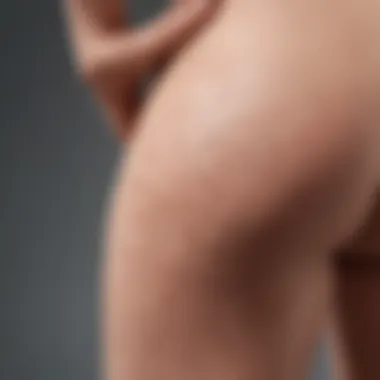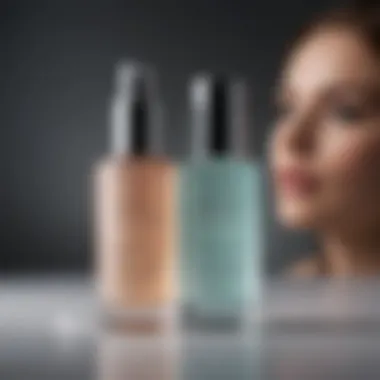Effective Strategies to Eliminate Post-Shaving Bumps


Intro
The experience of post-shaving bumps on legs is all too familiar for many women. These irritating bumps can occur after a fresh shave and often signal issues like ingrown hairs or skin irritation. Understanding how to manage and prevent these bumps is essential for achieving that smooth, polished appearance that many women desire. This guide aims to offer effective strategies to help you eliminate post-shaving bumps, empowering you to enhance your shaving routine and address the common challenges associated with leg shaving.
By exploring the causes, implementing prevention techniques, and considering appropriate treatments, you can significantly improve your shaving experience. Let's begin dissecting these elements for smoother skin and more confidence in your beauty routine.
Understanding Post-Shaving Bumps
Understanding post-shaving bumps is essential for maintaining smooth skin after leg shaving. These bumps can be a common annoyance for many individuals, particularly women. They detract from the polished appearance and can lead to discomfort and self-consciousness. By grasping the factors that contribute to these bumps, one can effectively reduce their occurrence, leading to a more enjoyable shaving experience. This section focuses on the causes behind these bumps and emphasizes the importance of proper technique and aftercare.
What Causes Bumps After Shaving
Folliculitis Explained
Folliculitis is a condition that occurs when hair follicles become inflamed. After shaving, bacteria or fungi can invade the tiny openings in the skin. This results in red, itchy bumps around the hair follicles. A key characteristic of folliculitis is that it can appear similar to acne, making it easy to misidentify. Understanding this skin condition is beneficial as it helps one differentiate between regular post-shaving irritation and folliculitis. The unique feature of folliculitis is that it can be caused by improper shaving techniques, such as using a dull razor. This condition poses a disadvantage as it may require topical treatments or more advanced measures if left untreated, complicating the wellness journey.
Ingrown Hairs: A Closer Look
Ingrown hairs emerge when hair curls back into the skin instead of growing outward. This commonly occurs after shaving, particularly in areas with thicker hair. The key feature of ingrown hairs is the painful red bumps that can form under the skin. Their recognition is important in addressing post-shaving concerns. A painful issue, ingrown hairs can arise from shaving against the hair's natural growth direction, highlighting why proper shaving methods are crucial. The main disadvantage is the potential for scarring and persistent irritation, which can overshadow the benefits of smooth skin.
Skin Irritation and Inflammation
Skin irritation and inflammation often arise from various factors such as harsh shaving products or sensitive skin types. These reactions can lead to redness and discomfort after shaving. A key characteristic is that they usually present as an overall rash rather than individual bumps. This information is vital for understanding how to select the right products for sensitive skin. The unique feature about this type of irritation is that it can often be mitigated by switching to more gentle products. However, persistent irritation may indicate an underlying skin condition that requires additional care or advice from a healthcare professional.
Differences Between Bumps and Rash
In distinguishing bumps from rashes, it becomes clear that observing specific symptoms is critical in determining the appropriate response.
Identifying Follicular Issues
Identifying follicular issues helps in understanding whether bumps are folliculitis or a result of other irritants. A puffiness around hair follicles usually signals follicular problems. Recognizing this helps in addressing potential issues before they escalate. This knowledge empowers individuals to adopt appropriate measures to prevent recurence of these problems. Key advantages include better skin management and lower chance of severe reactions.
Recognizing Allergic Reactions
Recognizing allergic reactions is also integral to effective post-shaving care. These reactions may present as widespread red patches or welts. It is advantageous to differentiate this from regular bumps. An allergic reaction may require discontinuing the use of certain shaving products. Realizing the signs of such reactions can significantly aid in choosing compatible products and maintaining skin health. However, if the reactions persist, seeking professional advice might become necessary.
Prepping for a Successful Shave
Prepping your skin for a shave might seem trivial, but it is actually a critical part of achieving smooth, bump-free legs. Proper preparation helps ensure that the shaving process is less irritating to the skin and significantly reduces the chances of developing bumps afterwards. This section will explore critical elements of shave preparation, including the right tools, hydration, and exfoliation techniques. With the right groundwork, the skin can tolerate the shaving process much better.


Choosing the Right Tools
Razors: Disposable vs. Reusable
When selecting a razor, one must consider the differences between disposable and reusable options. Disposable razors are convenient and often less expensive as they can be easily replaced after a few uses. Their sharp blades can provide a clean shave, but they may lack durability for longer-term use. On the other hand, reusable razors offer a more sustainable choice designed for extended use. They usually come with replaceable blades, which can reduce waste over time. The key characteristic of reusable razors is their ergonomic designs, which provide better grip and control. Therefore, they can lead to fewer nicks and cuts when shaving.
Importance of Quality Shaving Creams
The choice of shaving cream is essential for protecting the skin during a shave. Quality shaving creams create a protective barrier and allow for a smoother glide of the razor. This can help prevent unnecessary irritation and bumps. The key characteristic of high-quality shaving creams is their ability to hydrate the skin, making it softer and easier to shave. Brands that include soothing ingredients like aloe vera or vitamin E could minimize the risk of post-shave bumps. Cheap or subpar creams can lead to more irritation and heightened chances of ingrown hairs.
The Role of Skin Exfoliation
Benefits of Regular Exfoliation
Regular exfoliation is crucial in preparing the skin for shaving. It removes dead skin cells that can trap hair and lead to ingrown hairs. As a result, exfoliating helps in achieving a closer shave and smoother legs. The benefit of incorporating regular exfoliation into your routine is increased skin brightness and texture. These efforts can make shaving easier and more effective, which is particularly valuable in avoiding post-shave bumps. Certain exfoliating scrubs that are gentle enough for regular use can be excellent for this purpose.
How to Exfoliate Safely
Exfoliation should be done carefully to avoid damaging the skin. It is recommended to exfoliate a day or two before shaving rather than on the same day. This minimizes the risk of irritation and allows the skin to recover. Safe exfoliation methods can include using gentle scrubs or chemical exfoliants that are formulated for sensitive skin. The crucial point to note is that over-exfoliation can lead to increased sensitivity, resulting in more bumps.
Hydration Before Shaving
Impact of Moisturized Skin
Hydration plays a significant role in the shaving process as well. Moisturized skin is generally more pliable and less prone to cuts and irritation during shaving. The key characteristic of well-hydrated skin is its elasticity, making it easier for razors to glide over without pulling at hairs. Using a moisturizer right before shaving can definitely improve the overall outcome and dramatically reduce the risk of bumps appearing after the shave.
Best Practices for Water Temperature
Water temperature is a vital aspect of preparing for shaving. Warm water is highly recommended, as it helps to open up hair follicles and soften the hair, making it easier to shave. Using warm water can enhance the effectiveness of shaving creams too. Cold water may tighten the skin and hair follicles, leading to a less effective shave. Therefore, achieving a balance with warm water is beneficial to ensure a smooth and successful shave.
Shaving Techniques for Smooth Results
Shaving techniques play a crucial role in achieving smooth and bump-free skin after shaving. The methods used during shaving can either aggravate or alleviate skin irritations. Emphasizing proper shaving techniques, women can reduce the occurrence of post-shaving bumps and encourage a healthier skin appearance. Key elements include angle, pressure, and stroke length, all of which can contribute to minimizing skin trauma and irritation. Understanding these techniques helps in developing a shaving routine that enhances the overall experience and results.
Proper Shaving Techniques
Shaving Direction: Short Strokes
Shaving direction is one of the critical aspects when aiming for smooth legs. Using short strokes, particularly in the direction of hair growth, helps to reduce pulling and minimizes irritation. Short strokes allow better control over the razor, which is especially beneficial for maneuvering around curves and contours of the legs. Additionally, this approach prevents the hair from being ripped out, further reducing the chances for ingrown hairs. A significant characteristic of this technique is its simplicity and effectiveness in preventing skin trauma.
The unique feature of using short strokes is that they can be adjusted based on individual comfort and hair growth patterns. This adaptability is valuable because everyone’s hair growth can vary significantly. However, users must remain attentive to how the skin reacts post-shaving, as overdoing short strokes in any direction could also lead to irritation.


Maintaining Razor Hygiene
Another essential element of shaving is maintaining razor hygiene. A clean razor is pivotal in reducing the risk of post-shaving bumps. The accumulation of hair, skin cells, and product residue can lead to infections or irritations. Keeping the razor clean not only ensures a closer shave but drastically lowers the chances of developing folliculitis or experiencing increased irritation.
An important characteristic of proper razor hygiene is regular replacement. A dull or dirty blade does not perform effectively and can result in uneven cuts, leading to irritation or injuries on the skin. The unique feature of this practice is its emphasis on long-term skin health. Regular cleaning, along with replacing the razor every few uses, enhances the effectiveness of the shave while protecting the skin from negative reactions.
Post-Shave Care
After shaving, proper post-care techniques are needed to ensure skin remains healthy and irritation-free. This step is just as important as the shaving itself. Two main aspects of post-shave care are cleaning and moisturizing techniques, as well as avoiding immediate exposure to irritants.
Cleaning and Moisturizing Techniques
Cleaning and moisturizing the skin post-shaving is critical for recovery and hydration. After shaving, the skin may be sensitive and prone to irritation, making gentle cleaning essential. Using a mild cleanser suitable for sensitive skin helps to remove any leftover shaving cream or hair, ensuring clean skin.
Moisturization plays a key role in the recovery process. Hydrating products help restore moisture to the skin, calming any post-shave irritation. The unique attributes of this technique lie in its ability to provide quick relief and long-lasting hydration. Opting for non-comedogenic moisturizers helps in maintaining clarity while preventing clogged pores.
Avoiding Immediate Exposure to Irritants
Lastly, avoiding immediate exposure to irritants after shaving is vital for preventing post-shave bumps. Skin is more sensitive after shaving, making it important to limit contact with things like sunscreen, lotions with fragrances, or tight clothing. The critical aspect here is allowing time for the skin to recover. Waiting at least 24 hours before applying harsher products or exposing the skin to potential irritants further promotes healing. This practice emphasizes patience and care in nurturing skin.
The unique feature is the simple nature of this technique; it merely requires awareness and mindfulness. Everyone can benefit from this practice by simply altering their immediate post-shave routine.
Treating and Preventing Bumps
Understanding how to treat and prevent post-shaving bumps is crucial for achieving smoother skin after shaving. The techniques discussed can reduce irritation and the chances of developing bumps significantly. Addressing this concern not only improves physical appearance but also fosters confidence, allowing individuals to feel comfortable in their skin. Thus, learning about home remedies and knowing when to seek professional help becomes essential in managing the after-effects of shaving.
Home Remedies for Immediate Relief
Home remedies offer quick solutions for those looking to alleviate discomfort after shaving. Natural products are popular among individuals who prefer gentle and effective options.
Aloe Vera and Its Benefits
Aloe vera is known for its soothing properties. This plant contains compounds that can help calm irritated skin and reduce redness. Its unique feature is the ability to hydrate the skin while providing a cooling sensation. This makes it an excellent choice for individuals seeking relief from post-shaving bumps. The gel extracted from aloe vera can be applied directly to the affected area. It offers hydration without clogging pores, thus preventing further irritation. Additionally, aloe vera has anti-inflammatory properties, contributing to faster healing. While generally safe, some individuals may be allergic, so patch testing is recommended before extensive use.
Coconut Oil as a Soothing Agent
Coconut oil is another effective remedy. Its key characteristic lies in its moisturizing abilities. It is rich in fatty acids, which help to lock in moisture and protect the skin's barrier. When applied after shaving, coconut oil can reduce irritation and promote healing. Its unique feature is that it can also act as an antibacterial agent, which is useful in preventing potential infections from any small cuts. While it has many advantages, some people with oily skin types may find it too heavy or pore-clogging.
When to Seek Professional Help


While home remedies can be effective, knowing when to seek professional help is also important. In certain situations, further expert care might be necessary.
Signs of Severe Irritation
Signs of severe irritation include pus-filled bumps, excessive redness, or persistent discomfort. Recognizing these symptoms is crucial for effective management. If the irritation worsens or does not improve with home treatments, it may indicate an infection. Such conditions may need more than topical remedies and require attention from a healthcare professional. Ignoring these signs might lead to worsening symptoms and prolonged recovery.
Consulting a Dermatologist
Consulting a dermatologist becomes vital if severe irritation occurs or if frequent bumps appear after shaving. A dermatologist can provide tailored advice, possible prescriptions, or explore underlying skin conditions that contribute to irritation. Their expert guidance can lead to better long-term skin care strategies. While seeking professional help can be daunting, the benefits of specialized advice often outweigh the discomfort, promoting overall skin health and well-being.
Long-Term Skin Care Strategies
Long-term skin care strategies play a vital role in preventing post-shaving bumps on legs. Managing your skin’s health on an ongoing basis is more effective than treating issues as they arise. When you regularly care for your skin, you not only enhance its appearance but also reduce the likelihood of irritation and other shave-related problems. There are specific elements to consider, including the use of moisturizers and targeted treatments for sensitive skin. Each aspect contributes to smoother skin and decreased chances of developing bumps after shaving.
Integrating Skincare into Your Routine
Integrating skin care into your daily routine can significantly elevate skin health. This can include various practices, and two key areas to focus on are daily moisturization techniques and targeted treatments for sensitive skin.
Daily Moisturization Techniques
Daily moisturization is a fundamental practice when aiming for healthy skin. Keeping the skin hydrated prevents dryness, which is a common cause of irritation post-shave. Moisturizers create a barrier that locks in hydration, making your skin feel soft and resilient. A significant characteristic of effective moisturizers is their ability to help maintain the skin’s natural barrier. A benefit of this practice is its simplicity; by incorporating a moisturizer into your daily routine, you can see visible improvements over time.
The unique feature of daily moisturization is the variety available based on skin type. Options range from light lotions to richer creams designed for extra dry skin. Choosing the right product is crucial. Some formulations may contain additives or fragrances that could irritate sensitive skin types, so always read labels carefully.
Targeted Treatments for Sensitive Skin
Targeted treatments for sensitive skin can complement a regular skincare routine. These treatments focus on addressing specific concerns such as redness, bumps, or irritation. A key characteristic of these products is their formulation, typically being gentler and free from harsh chemicals. This makes them a favorable choice for individuals who experience discomfort after shaving.
The unique aspect of these treatments is their concentrated nature, allowing them to offer immediate relief from irritation and redness. However, care must be taken, as some individuals may not respond positively to all treatments. Conduct a patch test to ensure compatibility with your skin type. Overall, integrating targeted treatments can provide an effective and calming solution.
Alternatives to Shaving
Seeking alternatives to shaving is another strategy. Many women explore methods like waxing and laser hair removal to avoid the inconveniences associated with bumps and irritations.
Waxes and Sugaring: Pros and Cons
Waxing and sugaring are popular hair removal techniques. They work by removing hair from the root, which can lead to smoother results compared to shaving. A notable characteristic of these methods is their longevity; hair takes longer to grow back. This can reduce the frequency of hair removal, simplifying the grooming routine.
However, there are disadvantages. Waxing can cause pain, and both methods may lead to skin irritation for some individuals. Care is needed to assess personal reaction rates. For optimal results, ensure the professional or product used is reputable and follows safe practices.
Laser Hair Removal: A Consideration
Laser hair removal presents a more permanent solution to hair removal. This method uses concentrated light beams to damage hair follicles, resulting in reduced growth over time. A significant characteristic is its effectiveness in reducing hair growth permanently. For many, this is appealing and can save time and effort in the long term.
Despite its advantages, laser hair removal often requires multiple sessions and can be costly. Additionally, there may be minimal side effects such as skin irritation or discoloration. Therefore, it’s important to weigh the benefits versus potential drawbacks carefully.
The key to long-term skin care strategies is consistency and attentiveness to what your skin needs. By incorporating effective techniques and considering alternatives to shaving, you can maintain healthy, smooth skin with minimal irritation.



